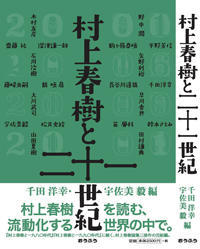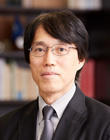The Themes of Haruki Murakami's New Full-Length Novel "The City and Its Uncertain Walls"
— Changes and Constants in the Works of Haruki Murakami —
Takeshi Usami/Professor, Faculty of Letters, Chuo University
Area of Specialization: Modern Japanese literature, modern culture studies
1. Changes in Haruki Murakami's style
Murakami's works are said to have changed since the mid-1990s. This is said to be a change "from detachment to commitment," and that his style has transitioned from focusing on the isolated inner lives of lonely young people to focusing more on a wide range of social issues, such as earthquakes and religion. On the other hand, others have said that the style of Murakami's works has not changed at all since his debut. They point out that the narrative style tends to involve the death or loss of a wife or lover, and that his unique style of writing that makes heavy use of metaphors has remained the same.
These observations may seem like contrasting points, but they are both true. The most distinctive feature of Murakami's style is the continuity of content from one work to another. The themes depicted in one work are carried over to the next, and further developed and explored. This may be criticized on the grounds that individually, the works lack independence and completeness, but another interpretation is to look at literature on a much larger scale that goes beyond individual works. In a sense, the continuity of common themes is something that has not changed in Murakami's work, while the way he constantly updates those themes is where the changes can be seen. The City and Its Uncertain Walls (Machi to Sono Futashikana Kabe), his first full-length novel in six years, showcases both the unchanging and the constantly changing aspects of his style.
2. Development of The City and Its Uncertain Walls
The City and Its Uncertain Walls is partially based on Murakami's previously published short novel of the same title (except with a comma added after "City," published in the September 1980 issue of Bungakukai). The short novel was never published as a book, and was eventually developed into Hard-Boiled Wonderland and the End of the World (Shinchosha, 1985). Murakami has frequently taken short novels that he has previously written, and developed them into full-length novels. A well-known example is the publication of Norwegian Wood (Kodansha, 1987), which came from a short story titled "Hotaru" ("Firefly") (Chuo Koron, January 1983 issue). This time, he has taken a short novel that he had already adapted into a full-length novel once, more than 40 years ago, into a new full-length novel. This makes this novel a unique creative undertaking for Murakami. He explains the process in the afterword of The City and Its Uncertain Walls.
"Although it was published in a magazine, I was never satisfied with the content (due to various circumstances around that time, I felt that it had been released to the world prematurely), and so I never made it into a book... However, I always felt from the beginning that this work contained something very important to me. Unfortunately, at that time, I didn't have the writing skills yet to write it as thoroughly as I needed to." (Loosely translated from the afterword of The City and Its Uncertain Walls)
Thus, it seems Murakami published this novel believing that now was the right time to revisit his past work and recreate it.
3. The "walls" and "shadows" depicted in The City and Its Uncertain Walls
What kind of novel is The City and Its Uncertain Walls?
The protagonists of the story are the 17-year-old "boku" and a middle-aged "watashi," both of which are words that translate to "me," but are appropriate for their respective ages. "Boku" is in a relationship with 16-year-old "kimi" (meaning "you"), who suddenly disappears. On the other hand, "watashi" lives quietly in a city surrounded by high walls, separated from his own shadow. This is the setting of the story, but like other works by Murakami, strange things happen one after another. First of all, what is "a city that people lives separately from its shadow"? This theme is at the heart of this novel. This setting and theme are shared between "The City, and Its Uncertain Walls" (1980), Hard-Boiled Wonderland and the End of the World (1985), and The City and Its Uncertain Walls (2023). The story explores "a city surrounded by high, solid walls" and "the lives of people who've lost their shadows." Naturally, the premise raises the question as to what these walls and shadows are. However, these ideas are not clearly explained in the work, nor is there even any attempt to do so. The novel leaves it up to us as readers to interpret these ideas.
4. What is the "city surrounded by walls?"
Nevertheless, there is a consistent theme of a walled city that is a common thread throughout the story. In the walled city, people live separated from their shadows. The separated shadows gradually become weak over time, and eventually die. The people who live in this walled city experience no conflict, curiosity, or regrets, but something is missing. This is the common theme that is presented in the worlds depicted in the aforementioned series of works.
So what is missing from the walled city?
"There is no such thing as 'substance' in this city. Do you understand? Everything is just part of the backdrop on the canvas. Think about it. When the sun goes down, the amusement park closes. That's the way things work." ("The City, and Its Uncertain Walls" Chapter 20).
"Look at it this way. The Town seems to contain everything it needs to sustain itself in perpetual peace and security. The order of things remains perfectly constant, no matter what happens. But a world of perpetual motion is theoretically impossible. There has to be a trick. The system must take in and let out somewhere." (Hard-Boiled Wonderland and the End of the World, Chapter 24)
"'Doesn't this place remind you of an amusement park?' said the shadow, with a weak laugh. 'The gates open in the morning and close when the sun goes down. The background, which looks like a portable backdrop, extends as far as we know. There are even wandering unicorns.'" (The City and Its Uncertain Walls, Chapter 16).
The walled city is stable and peaceful. However, this peace and stability feel artificial and fake. There is an essential element in the lives of human beings that is missing. Why did Murakami try to recreate this city, reaching as far back as 40 years for the setting of a short novel he once wrote?
5. Changes and constants in Murakami's works
Earlier, I wrote that Murakami's style is to continue with common themes found in his earlier works. In recent years, his works have often touched on the themes of the power that draws humans into the world of evil, as well as the inner worlds of cults. However, in The City and Its Uncertain Walls, there is no direct manifestation of evil, such as the Johnnie Walker character in Kafka on the Shore, nor is there a religious cult, such as the Sakigake cult in 1Q84. In this sense, The City and Its Uncertain Walls does not seem to continue with the common themes of Murakami's recent works. However, all of these works seem to be connected in a deep way.
The City and Its Uncertain Walls also provides the following descriptions on the "walls."
"And the walls redefined the city and its inhabitants with the goal of eliminating plagues of all kinds ーincluding what they consider to be 'plagues of the soul.' They redefined the city in its entirety. Then, they created a tightly closed-off system that was a complete entity in and of itself. Is this what you're trying to say?"(The City and Its Uncertain Walls, Chapter 50)
The completeness, sturdiness, and isolated nature of the "system" is shown here. These are themes that Murakami has frequently explored in his recent works. For example, Murakami has often depicted cults, largely because their complete, sturdy, and isolated "systems" are powerful forces that draw people in, while also posing the danger of eroding people's minds. In his acceptance speech for the Jerusalem Prize (2009) in Israel, he said, "And each of us, to a greater or lesser degree, is confronting a high, solid wall. The wall has a name: it is 'the System.'" This sentiment resonates with the themes he explores. In this sense, The City and Its Uncertain Walls continues to explore these same themes. He is repeating his warnings of the dangers posed by people surrendering to the system.
In The City and Its Uncertain Walls, Murakami does not touch on the power that draws people to the world of evil, nor the inner worlds of cults. This is one way in which Murakami's writings have changed. However, there is consistency in the themes that are depicted. In this sense, the overarching themes that Murakami pursues remain unchanged. The City and Its Uncertain Walls clearly showcases both the changes and the constants found in Murakami's works.
【Note】
This article will be published one week after the publication of The City and Its Uncertain Walls. Since many readers of this article may not have read the book yet, I have intentionally avoided mentioning specific plot details or the ending of the second half of the book.
Takeshi Usami/Professor, Faculty of Letters, Chuo University
Area of Specialization: Modern Japanese literature, modern culture studiesTakeshi Usami was born in 1958 in Tokyo. He graduated from the Faculty of Education, Tokyo Gakugei University in 1980. He completed his doctoral course at the Graduate School of Humanities, The University of Tokyo in 1990. He is a Doctor of Literature (Chuo University). He took his current post in 1998 after teaching as a full-time lecturer and as an assistant professor at the Faculty of Letters, Chuo University.
He analyzes modern literature through literary figures, such as Haruki Murakami, from a historical perspective, and studies the history of novels written after the Meiji period. In recent years, he has been leading efforts to establish a comprehensive study of fiction that includes film, theater, and television dramas in addition to literature, with a special focus on television drama studies.
Major publications include Shosetsu Hyogen toshite no Kindai (Modern Times Through Novelistic Expressions) (Ohfu), Murakami Haruki to Sen-Kyuhyaku-Hachiju Nendai (Haruki Murakami and the 1980s), Murakami Haruki to Sen-Kyuhyaku-Kyuju Nendai (Haruki Murakami and the 1990s), Murakami Haruki to Niju Isseiki (Haruki Murakami and the 21st Century) (joint editorship, Ohfu), and TV Drama wo Gakumon suru (Studying TV Dramas) (Chuo University Press), among others.
Website: Takeshi Usami's Faculty Office, Chuo University











